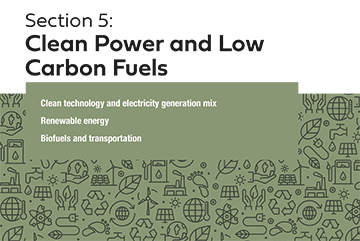Learn more about clean power and low carbon fuels in Canada in Section 5 of the Energy Fact Book including:
Key facts
- In 2022, Canada produced 639 terawatt hours of electricity.
- 70% of Canada's electricity comes from renewable sources and 82% from non-greenhouse gas (non-GHG) emitting sources such as solar, hydro, wind and nuclear power.
- Canada is the world's third largest producer of hydroelectricity. 62% of Canada's electricity comes from hydroelectric sources.
- In 2022, Canada was the world's second largest producer and second largest exporter of uranium. Nuclear power plants generate about 13% of Canada's electricity.
- Canada exports about 7% of the electricity it generates to the United States.
- Transportation GHG emissions increased 4% from 2020 to 2022, though they remain 8% lower than their pre-pandemic level in 2019.
- In 2023, electric vehicle (EV) registrations made up 10.8% of total vehicle registrations. Over 184,000 plug-in EVs were registered in 2023, more than nine times the number of registrations in 2017.

 Download the full Energy Fact Book, 2024-2025 (PDF, 23.28 MB)
Download the full Energy Fact Book, 2024-2025 (PDF, 23.28 MB) Download Section 5 of the Energy Fact Book, 2024-2025 (PDF, 10.63 MB)
Download Section 5 of the Energy Fact Book, 2024-2025 (PDF, 10.63 MB)